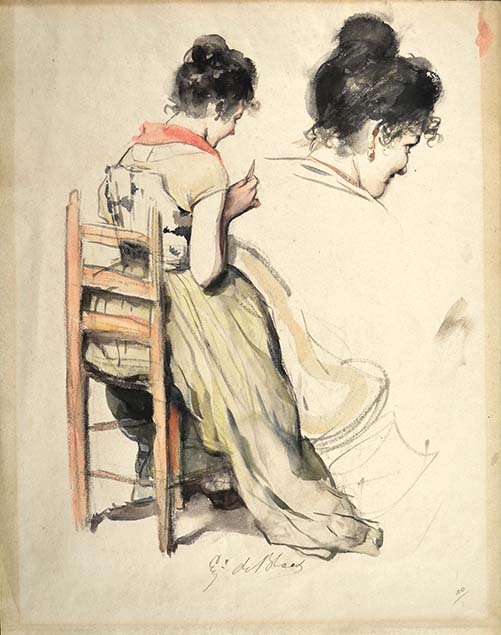(Albano (Rome) 1843 - Venice 1932)
SEATED YOUNG WOMAN SEWING
Brush and watercolours. Signed bottom center in pen and brown ink Eg deBlaas. 476 x 380 mm.
Numbered 10 in black chalk bottom right.
REDUCED PRICE
previous price was € 1100
Eugene de Blaas was born into a family of accomplished artists. His father Karl von Blaas, a portrait, history and fresco painter as well as a sculptor, was a professor at the Vienna Academy of Fine Art followed by the Venice Academy of Fine Art. Eugene's brother Julius was a painter of battle scenes and animals as well as an established watercolorist, who later on became a professor at the Academy in Rome. The family, originally from Austria, relocated initially to Rome, where Eugene and Julius were born, followed by Venice due to Karl's posting at the Academy. Eugene then attended the Academy in Rome, where he later became a professor, followed by the Academy in Venice. His art was well received in England, allowing him to exhibit consistently at the Royal Academy, the Grafton Gallery and the New Gallery between 1875 and 1892. The most frequently handled subjects in Eugene de Blaas' art are Venetian washerwomen, street vendors and seamstresses who are striking in their youthful and unadorned beauty. He depicts them with photographic realism and a high finish. Eugene typically found inspiration from the everyday lives of such ordinary folk and his art mirrors the tenderness and affinity he feels for them. He also portrays his adoration for and marvel over the Italian, particularly the Venetian lifestyle and mood as well as the romantic urban texture of this city. In the context of such sentiments, Venice was the most suitable site for his oeuvre as it presented the artist with a never-changing environment as well as temperament. The city, due to its wealth in architectural and artistic inheritance together with a shortage in space to further expand upon, remained relatively unaffected by the fast paced changes presented by the industrial revolution. This time capsule allowed Eugene de Blaas to paint idyllic common folk without being consumed by a sense of melancholic nostalgia, unlike his Barbizon counterparts

